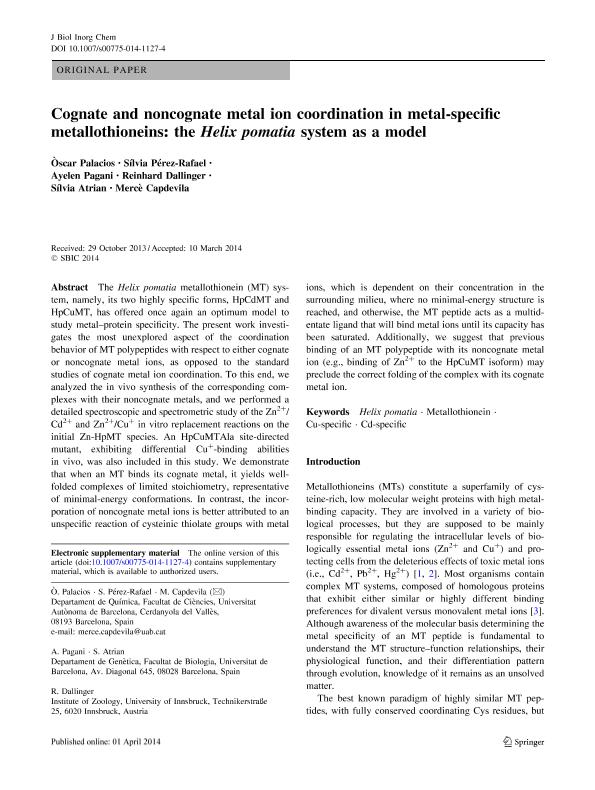Mostrar el registro sencillo del ítem
dc.contributor.author
Palacios, Oscar
dc.contributor.author
Perez Rafael, Silvia
dc.contributor.author
Pagani, María Ayelén

dc.contributor.author
Dallinger, Reinhard
dc.contributor.author
Atrian, Silvia
dc.contributor.author
Capdevila, Merce
dc.date.available
2024-04-17T12:34:00Z
dc.date.issued
2014-04
dc.identifier.citation
Palacios, Oscar; Perez Rafael, Silvia; Pagani, María Ayelén; Dallinger, Reinhard; Atrian, Silvia; et al.; Cognate and noncognate metal ion coordination in metal-specific metallothioneins: The Helix pomatia system as a model; Springer; Journal of Biological Inorganic Chemistry; 19; 6; 4-2014; 923-935
dc.identifier.issn
0949-8257
dc.identifier.uri
http://hdl.handle.net/11336/233263
dc.description.abstract
The Helix pomatia metallothionein (MT) system, namely, its two highly specific forms, HpCdMT and HpCuMT, has offered once again an optimum model to study metal?protein specificity. The present work investigates the most unexplored aspect of the coordination behavior of MT polypeptides with respect to either cognate or noncognate metal ions, as opposed to the standard studies of cognate metal ion coordination. To this end, we analyzed the in vivo synthesis of the corresponding complexes with their noncognate metals, and we performed a detailed spectroscopic and spectrometric study of the Zn2+/Cd2+ and Zn2+/Cu+ in vitro replacement reactions on the initial Zn-HpMT species. An HpCuMTAla site-directed mutant, exhibiting differential Cu+-binding abilities in vivo, was also included in this study. We demonstrate that when an MT binds its cognate metal, it yields well-folded complexes of limited stoichiometry, representative of minimal-energy conformations. In contrast, the incorporation of noncognate metal ions is better attributed to an unspecific reaction of cysteinic thiolate groups with metal ions, which is dependent on their concentration in the surrounding milieu, where no minimal-energy structure is reached, and otherwise, the MT peptide acts as a multidentate ligand that will bind metal ions until its capacity has been saturated. Additionally, we suggest that previous binding of an MT polypeptide with its noncognate metal ion (e.g., binding of Zn2+ to the HpCuMT isoform) may preclude the correct folding of the complex with its cognate metal ion.
dc.format
application/pdf
dc.language.iso
eng
dc.publisher
Springer

dc.rights
info:eu-repo/semantics/openAccess
dc.rights.uri
https://creativecommons.org/licenses/by-nc-sa/2.5/ar/
dc.subject
HELIX POMATIA
dc.subject
METALLOTHIONEIN
dc.subject
CU-SPECIFIC
dc.subject
CD-SPECIFIC
dc.subject.classification
Otras Ciencias Químicas

dc.subject.classification
Ciencias Químicas

dc.subject.classification
CIENCIAS NATURALES Y EXACTAS

dc.subject.classification
Otras Ciencias Biológicas

dc.subject.classification
Ciencias Biológicas

dc.subject.classification
CIENCIAS NATURALES Y EXACTAS

dc.title
Cognate and noncognate metal ion coordination in metal-specific metallothioneins: The Helix pomatia system as a model
dc.type
info:eu-repo/semantics/article
dc.type
info:ar-repo/semantics/artículo
dc.type
info:eu-repo/semantics/publishedVersion
dc.date.updated
2024-04-03T13:36:47Z
dc.identifier.eissn
1432-1327
dc.journal.volume
19
dc.journal.number
6
dc.journal.pagination
923-935
dc.journal.pais
Alemania

dc.journal.ciudad
Berlin
dc.description.fil
Fil: Palacios, Oscar. Universitat Autònoma de Barcelona; España
dc.description.fil
Fil: Perez Rafael, Silvia. Universitat Autònoma de Barcelona; España
dc.description.fil
Fil: Pagani, María Ayelén. Universidad de Barcelona; España. Consejo Nacional de Investigaciones Científicas y Técnicas. Centro Científico Tecnológico Conicet - Rosario. Centro de Estudios Fotosintéticos y Bioquímicos. Universidad Nacional de Rosario. Facultad de Ciencias Bioquímicas y Farmacéuticas. Centro de Estudios Fotosintéticos y Bioquímicos; Argentina
dc.description.fil
Fil: Dallinger, Reinhard. Universidad de Innsbruck; Austria
dc.description.fil
Fil: Atrian, Silvia. Universidad de Barcelona; España
dc.description.fil
Fil: Capdevila, Merce. Universitat Autònoma de Barcelona; España
dc.journal.title
Journal of Biological Inorganic Chemistry

dc.relation.alternativeid
info:eu-repo/semantics/altIdentifier/doi/http://dx.doi.org/10.1007/s00775-014-1127-4
dc.relation.alternativeid
info:eu-repo/semantics/altIdentifier/url/https://link.springer.com/article/10.1007/s00775-014-1127-4
Archivos asociados
